March 28, 2008
Air Date: March 28, 2008
FULL SHOW
SEGMENTS
Mid-America Wades in the Water
View the page for this story
Torrential rains and overflowing rivers and levees have devastated many areas of the country, including Arkansas. Sandra Patterson of the Office of Emergency Management in Des Ark, Arkansas tells host Bruce Gellerman about the toll the floods are taking in her county. We then turn to Tim Kusky, professor of natural sciences at St. Louis University, who says that levees and climate change have made the 100 year flood a misnomer. (06:00)
Toxic Trailers
/ Ingrid LobetView the page for this story
FEMA, the government’s disaster recovery agency, is evacuating people from trailers they provided as temporary housing after Hurricane Katrina, after determining the air was contaminated with formaldehyde. But as Living on Earth’s Ingrid Lobet reports, it took lots of pressure, including congressional hearings, to convince FEMA to make the move. (05:30)
Coal v. Climate in Kansas
/ Jeff YoungView the page for this story
Kansas is on the frontlines in a fight over coal-fired power and climate change. We’ll hear from the Kansas official who took a stand against coal and its greenhouse gas emissions as Living on Earth’s Jeff Young tells us what’s behind the battle and what it might mean for the rest of the country. (05:40)
From Megawatts to Negawatts
View the page for this story
Instead of consuming megawatts, the founder of the Rocky Mountain Institute says we need to be producing negawatts. Host Bruce Gellerman talks with Amory Lovins about his energy efficient lifestyle. (05:40)
Green Grocer
View the page for this story
A Whole Foods store in Connecticut is the first supermarket in the country to get all its power from a stationary fuel cell. Host Bruce Gellerman talks with Bob Remick, director of the National Renewable Energy Lab, about how fuels cells work and the promise of fuel cell technology. (06:20)
The Art of Global Warming
/ Mitra TajView the page for this story
Living on Earth's Mitra Taj visits the art exhibition "Greed, Guilt, and Grappling: Six Artists Respond to Climate Change," in Boston and finds that thinking about rising global temperatures with the right side of the brain can be fun. (06:30)
Learn about the Fern
/ Bruce GellermanView the page for this story
Ferns usually play second fiddle to wildflowers in the garden but they take center stage in William Collina’s new book “Native Ferns, Moss and Grasses”. Living on Earth host Bruce Gellerman tours the nation’s premier botanical garden for native plants with the author. (09:50)
This week's EarthEar selection
listen /
download
Migrating water fowl are all aflutter.
Show Credits and Funders
Show Transcript
HOST: Bruce Gellerman
GUESTS: Sandra Patterson, Tim Kusky, Amory Lovins, Bob Remick, Bill Cullina
REPORTERS: Ingrid Lobet, Jeff Young, Mitra Taj
[THEME]
GELLERMAN: From Public Radio International, this is Living on Earth.
[THEME]
GELLERMAN: I’m Bruce Gellerman.
Hundreds of thousands of acres of America are under water as the mighty Mississippi and other rivers break their banks. It seems a hundred year flood ain’t what it used to be…
KUSKY: Well, that’s becoming a bit of a misnomer because we’ve had around six or seven or even eight hundred year floods in the past hundred years.
GELLERMAN: Also, artists confront and shed some light on climate change.
TAGIURI: I’ve been photographing people from the community, and I dress them up sort of like the Statue of Liberty. They have an American flag wrapped around them and a green crown and I get them to hold a giant compact fluorescent light bulb up like a torch.
GELLERMAN: And celebrating America’s native greenery: ferns, moss and grasses. We get down and dirty along the garden path. These stories and more this week on Living on Earth. Stick around!
Mid-America Wades in the Water

A house goes under in Jefferson County, Missouri. (Photo: Kristin Badolato)
ANNOUNCER: Support for Living on Earth comes from the National Science Foundation and Stonyfield Farm.
[THEME RETURN]
GELLERMAN: From the Jennifer and Ted Stanley Studios in Somerville, Massachusetts – this is Living on Earth. I’m Bruce Gellerman, in for Steve Curwood.
Torrential thunderstorms have been soaking the middle of America. From Illinois to Mississippi, rivers have overflowed their banks and levees flooding hundreds of thousands of acres, devastating crops, filling homes and businesses with water, killing at least 17 people.
Arkansas has been particularly hard hit. When I spoke with Sandra Patterson, coordinator for the Office of Emergency Management for Prairie County, she was waiting to learn if her county would join 35 others in Arkansas that had already been declared federal disaster areas.
PATTERSON: It’s pretty bad. Probably 35 percent of our county is under water. The last time we had a flood this large was in 1973 and that was the biggest one since our ’49 flood, which was 37 feet.
GELLERMAN: But you knew this was going to happen, right?
PATTERSON: We didn’t know we were going to get this much water. It was predicted about three feet lower. And then, all of the sudden, the water just kept coming so fast and we had dams break north of us that put more water down on us. When it finally got here, it just backed up so fast you could almost see it moving. It kind of overwhelmed everybody.

The Gasconade River pours over a highway near Mt. Sterling, Missouri.(Photo: Drew Backues)
PATTERSON: We’ve declared an emergency here in Prairie County. We’re waiting on FEMA maybe or the president to, hopefully, declare us a federal disaster so we maybe can get some assistance. We know we’ve got washed out culverts and we know we got washed out roads. You know, we don’t have the money to fund it and maybe not even the manpower to get this stuff fixed back.
GELLERMAN: Well, Ms. Patterson, good luck, thank you very much.
PATTERSON: Thank you.
GELLERMAN: Sandra Patterson is coordinator for the office of emergency management for Prairie County, Arkansas. Tim Kusky teaches natural science at St. Louis University and is the director of the Center for Environmental Sciences there. He says flooding along the Mississippi River is all too familiar.
KUSKY: That’s right, we’ve been getting more and more floods as time goes on along the Mississippi and Missouri River systems.
GELLERMAN: Well, they’re saying that this is one of those floods that occurs once in a hundred years.
KUSKY: Well, that’s becoming a bit of a misnomer because we’ve had around six or seven or even eight hundred year floods in the past 100 years.
GELLERMAN: Eight in one hundred years?
KUSKY: Yeah, well we’ve had devastating floods here in ’93, ’73, ’51, ’37, 1929, ’27, 1890, 1874, going way back in time. They happen over and over again.
GELLERMAN: Are they happening in the same place and are they happening for the same reason?
KUSKY: Well, they’re getting worse for any given amount of water. There’s a few different reasons for this. One of the reasons is that over the past 150 years or so we’ve built around 2,200 miles of levees and other constructions that serve to constrict and confine the river channel along the Mississippi and Missouri River systems. So, when we make the river narrower what happens is that we make the flood stages or the flood heights become higher. It makes it rise faster. It makes the water move faster downstream and increases its erosive power that can knock down levees and cause devastating floods.

Timothy Kusky is a professor of natural sciences at St. Louis University. (Courtesy of St. Louis University)
KUSKY: Yeah, that’s another problem is that even if the water was to flow across the flood plain it can’t seep into the soils as much as before because we’ve developed the flood plains extensively. For instance, since the 1993 flood in the St. Louis area we’ve built around close to 30,000 new homes in areas that were under ten feet of water in ’93. So, those areas are now impervious to water and all that water has to go somewhere.
GELLERMAN: Don’t people realize this? I mean, you know, flood me once shame on you, flood me twice shame on me.
KUSKY: It should be that way but what happens is that people don’t really understand that the risk is increased the more and more we build levees.
GELLERMAN: I know that one of the largest, if not the largest, strip mall in the United States is just west of St. Louis and they built it with a levee that was supposed to be in a one in 500 years flood plain.
KUSKY: Yeah, that’s in the Chesterfield Valley. That area has seen more development since the ’93 flood than in the entire previous history of the region. And all of that area was under about 10 feet of water in ’93. And what people have done is made calculations of the risk of things they call the 100-year flood or the 500-year flood based on old data. So, those risks are actually higher than previously thought. And another factor that’s coming into play here is that climate models predict that within 30 years we’re going to be receiving around 20 percent more rainfall in this area which equates to about 50 percent more water flowing through the rivers at any given time throughout the year.

A house goes under in Jefferson County, Missouri.(Photo: Kristin Badolato)
KUSKY: Well, it means it’s not going to be a 500-year levee anymore. It means that places where these kinds of changes happened before, things like the 100-year flood suddenly become about the seven-year flood.
GELLERMAN: Why does it always surprise people along there? Why do we always see these floods happening and people in trees?
KUSKY: Well, the attraction to building a levee is that if you’re in a town that gets flooded every once in a while you would like to build a levee around your town to feel safer. And the politicians and the developers will tell you that once you build this levee you’re going to be safe. And that might be true. You might increase your safety by building a very strong powerful levee. But the more and more of them that we build, we’re displacing that water that could have flowed into those areas and we’re making the water rise higher somewhere else. So, you build a levee, then your neighbor builds a levee that’s higher then you have to build your levee higher. And it just gets worse and worse and worse.
GELLERMAN: Dr. Kusky, thank you very much.
KUSKY: Thank you and have a nice day.
GELLERMAN: Stay dry.
KUSKY: Yeah, thank you.
GELLERMAN: Tim Kusky teaches natural science at St. Louis University.
Related link:
Timothy Kusky’s Homepage
[MUSIC: Victor Wooten “Sifu” from Palmystery (Heads Up Records – 2008)]
Toxic Trailers
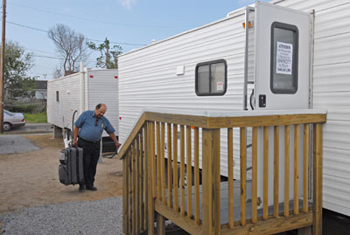
Herbert Jolly moving into a FEMA trailer in 2006. FEMA is now evacuating trailers because of poor air quality. (Photo: Marvin Nauman, Courtesy of FEMA)
GELLERMAN: Of course, the poster child for levees that don’t hold back the water is New Orleans. Even today, over two and a half years after Hurricane Katrina struck the Gulf Coast, some 90 thousand former residents are still stuck in trailers provided by FEMA, the Federal Emergency Relief Agency.
But tests indicate a third of the trailers have dangerously high levels of the toxic chemical formaldehyde. And particularly vulnerable are children and the elderly living in the mobile homes. FEMA officials now say they’re relocating residents in trailers as fast as possible, but as Living on Earth’s Ingrid Lobet reports, it took persistent pressure from Congress and those displaced by Katrina to get FEMA to finally act.
LOBET: For sixteen months in 2006 and 7, Paul Stewart told his story to anyone who would listen. But he got his big chance last summer when he came to Washington and spoke before the House Committee on Government and Oversight.
STEWART: The first night we stayed in the camper, my wife woke up several times with a runny nose. At one point, she turned the light on and realized that her runny nose was actually a bloody nose. I was also beginning to show symptoms of my own, which included scratchy eyes, scratchy throat, coughing and runny nose.
LOBET: Stewart kept an air filter running, but the couple's symptoms continued for weeks and months.
STEWART: And we finally thought about just leaving, but at the time we couldn’t leave. We were still fighting with the Army Corps of Engineers, with FEMA. We had debris all over our yard, money was short and we were stuck.
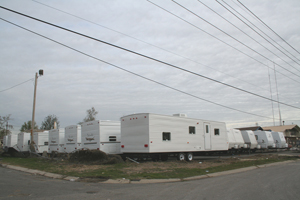
FEMA trailers in a parking lot in Chalmette, Louisiana. (Photo: David Danzig)
LOBET: Stewart testified that each time he called FEMA, he was just told to open the windows.
STEWART: They also told me that some people are “just more chemically sensitive than others.” That statement kind of made me angry. As a former U.S. Army infantry officer and as a former police officer I’ve been tazed, pepper sprayed, I’ve been through CS gas chambers and I do not consider myself to be a chemically sensitive person.
LOBET: Finally, Stewart ordered a kit and tested the air in his own camper. Formaldehyde levels inside, with the windows open and an air filter running, measured 220 parts per billion. That's 27 times the government safe level for long-term, round-the-clock exposure. FEMA employees on the ground on the Gulf Coast heard many complaints similar to Paul Stewart's. They urged their bosses to test other mobile homes. But according to documents obtained by congressional subpoena, FEMA attorneys said ‘no,’ because the agency could be liable for what it found.
Following last summer's hearing, officials did finally test more than 500 trailers. Formaldehyde levels in many of them were high enough to sicken a significant segment of the population. So now, FEMA has redoubled its efforts to move people into permanent housing, scarce in many parts of southern Louisiana and Mississippi.
Throughout the FEMA trailer controversy, some officials have expressed uncertainty about harmful levels of formaldehyde, a toxic irritant and carcinogen. This is FEMA administrator R. David Paulison at last summer's Congressional hearing:
PAULISON: Despite 30 years of research and reports on numerous federal agencies, there is now no existing consensus on safe formaldehyde levels in residential dwellings, so again we are looking to the experts for advice.
LOBET: More recently, FEMA fact sheets reassuringly said that formaldehyde levels in trailers were lower than what workers are allowed to be exposed to in an eight-hour shift. And a local newspaper reported this month a public health service officer told people in Mississippi the long-term effects of breathing high levels of formaldehyde is unknown. We contacted his boss, Michael McGeehin, Director of the CDC’s Division of Environmental Hazards and Health Effects, to ask if this reflects the agency's view.
MC GEEHIN: Except for that the fact that formaldehyde is a known carcinogen, yes the long-term effects are not well established and need more research.
LOBET: The state of California sets its own limits for air contaminants. State toxicologist Richard Lam doesn't agree there's a shortage of information about formaldehyde.

Herbert Jolly moving into a FEMA trailer in 2006. FEMA is now evacuating trailers because of poor air quality. (Photo: Marvin Nauman, Courtesy of FEMA)
LOBET: Formaldehyde in low concentrations surrounds us; it's in roadway exhaust, draperies and the exhaust from gas appliances. California has set a goal of two parts per billion in indoor or outdoor air, a level the state's experts say presents no health risk. That's four times stricter than the federal government's minimal risk level.
In order to remove formaldehyde from the air, California is now cracking down on major sources of the gas in people's homes, including plywood and particleboard. The new rules will reduce emissions by more than half in three years, beginning in July. The Sierra Club is lobbying EPA to take these rules nationwide.
Richard Lam says the thing to remember is that substances that cause cancer have no safe threshold. So the goal is to minimize any extra exposure.
LAM: There is no level at which exposure to a carcinogen is considered safe.
LOBET: Meanwhile members of Congress continue to investigate whether federal health agencies, including the CDC, retaliated against a federal scientist who voiced concerns about FEMA trailers and whether they diluted warnings about the health consequences of formaldehyde levels in the homes. The next hearing is April 1st.
For Living on Earth I’m Ingrid Lobet.
Related links:
- To read about the findings on air quality in FEMA trailers, click here
- ToxicTrailers.com
[MUSIC: Olu Dara “When I See You” from Goin Home: Tribute To Fats Domino (Vanguard Records – 2007)]
GELLERMAN: Coming up – saying ‘no’ to more power plants: the negawatt.
Keep listening to Living on Earth.
Coal v. Climate in Kansas
GELLERMAN: It’s Living on Earth. I’m Bruce Gellerman.
Kansas – the very heart of Heartland America – finds itself on the frontline of a fight over climate change and coal. It’s one of the many states wrestling with the tough issue: it needs more electricity, but officials are concerned about the greenhouse gases produced by coal-fired power plants. In Kansas, they’re taking a stand against coal, blocking permits for two new power plants. Living on Earth’s Jeff Young has been following the story and Jeff, it seems this story has turned into a real showdown, huh?
YOUNG: This is a high-stakes standoff. The company, Sunflower Electric, and its supporters say we need this power and this is a three and a half billion-dollar project that would create lots of jobs.
Kansas Governor Kathleen Sebelius and her environment secretary say ‘well, Kansas doesn’t really need all that electricity – most of it would go out of state.’ And a 1400 megawatt coal plant would put out a lot of greenhouse gases – about 11 million tons of carbon dioxide a year. So far, neither side has blinked. And electric utilities and lawmakers all around the country are watching to see how this is going to play out.
GELLERMAN: Well, tell me more about the Governor’s decision, Jeff. What’s the rationale for blocking the permit?
YOUNG: Well, in Kansas the state’s health and environment secretary makes the decisions on permits for power plants, and that’s a man named Rod Bremby. Bremby’s staff had approved the company’s permit – they just looked at the traditional air pollution concerns. But Bremby also looked at the science on climate change. He looked at the U.S. Supreme Court’s ruling from last year that said greenhouse gases are pollutants under the law, too. And Bremby told me that he felt he just could not ignore those things.
BREMBY: My staff did their job. They did an excellent job in reviewing the permit in the traditional sense. But because of a Supreme Court decision, because of additional information about climate change, I felt that it was my obligation, if you will, to make this decision. And we’re talking 40, 50 years of producing some 11 million tons of CO2 a year. And so, that’s just a little vantage point from which I decided that, no, we needed to act on this. I made a decision to say, we will deny this permit.
GELLERMAN: Wow, that’s a big deal. So, how did the power industry respond?
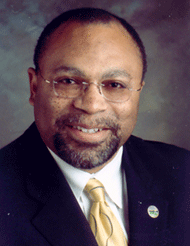
Kansas Health and Environment Secretary Rod Bremby.(Courtesy of the Kansas Department of Health and Environment)
YOUNG: Well, this is not an industry that’s accustomed to hearing ‘no.’ And so they fought back with kind of a nasty ad campaign aimed at the governor funded by Peabody Coal. They also lobbied very heavily at the statehouse. The Republican-controlled legislature responded to that with a bill that would let Sunflower build its power plants, and would strip Secretary Bremby of his authority to make those kinds of decisions about CO2 emissions.
GELLERMAN: Hmm. And the governor just vetoed that, right?
YOUNG: That’s right. Governor Sebelius, she’s a Democrat, she vetoed the bill. She also offered a compromise that would allow a smaller coal power plant if the company also committed to more wind power, more energy efficiency, things like that. The company says that’s too expensive. They serve a rural area with a lot of senior citizens, people on low-incomes – they want to go with the cheapest fuel that’s available. A lot of people I spoke to say this is probably heading for the state supreme court.
GELLERMAN: Now Jeff, you mentioned that a lot of people around the country are watching this. What do you think they’ve learned so far?
YOUNG: Yeah, you know what Kansas is going through – it goes right to the core of some really big questions. You know, sure, coal is cheap, but aren’t we just ignoring the environmental costs? And just how are we going to meet both energy demand and the challenge of climate change? These are big, big issues. So I asked a spokesperson for Sunflower Electric – his name is Steve Miller – what he would tell other power companies.
MILLER: Well, there’s no question that if you were to build a coal-fired power plant, you’re gonna have more lawsuits than you can know what to do with. I think they just have to decide how hard they want to fight for low-cost power. That’s really it. Because it’s gonna be a horrible fight, a very emotional fight, it’s gonna be a very expensive fight. And you just have to be able to measure when that ceases to be the right thing to do for your customers.
GELLERMAN: Hmm. Voice of experience. Sounds like he’s a little battle weary there, Jeff. What about the environment secretary, Mr. Bremby. What does he say is the lesson from all this?
YOUNG: Well, for Mr. Bremby, the main lesson is that we need federal action.
BREMBY: You know, if the EPA had been responsive to the Supreme Court’s ruling, I don’t know that we would be here. This has been a very contentious issue for Kansas. And we really shouldn’t be here. No state should be placed in this position. It’s important now that the federal government step up and try to fill that breach, so that we don’t find more conflict at the local level.
YOUNG: And, you know, Bruce, the interesting thing about that point is both sides are in agreement there. Everyone I spoke to, they all say, ‘we need Washington to act on this.’ Now, they might not want the same kind of action out of Washington, but it’s pretty clear that the uncertainty around all of this has just become paralyzing. State lawmakers can’t set good policy, industry can’t make good investment decisions unless they know what the rules are.
GELLERMAN: Living on Earth’s Jeff Young in Washington. Jeff, thanks a lot.
YOUNG: You’re welcome.
GELLERMAN: You can learn more about the Kansas showdown at our website, and while you’re there, check out our series “Generating Controversy—the Changing Climate of Coal.” It’s all at LOE dot ORG.
Related links:
- To read the veto and compromise offer from Governor Kathleen Sebelius, click here
- Kansas Health and Environment Secretary Rod Bembry’s testimony before Congress
- Sunflower Electric Power
- LOE’s series on coal, “Generating Controversy”
From Megawatts to Negawatts
GELLERMAN: So, if you can’t make more megawatts how about producing negawatts?
The idea of the negawatt conserving energy through greater efficiency started out as a typo – an “n” in place of an “m”. Energy activist Amory Lovins came across the mistake in a Colorado Public Utilities Commission report. The goof caught his fancy, and may help us power our future.
Amory Lovins founded the Rocky Mountain Institute, a think tank that focuses on energy issues. He was in Hawaii when I caught up with him by phone and asked him about the negawatt.
LOVINS: A negawatt is electricity that’s saved by using it more efficiently or at a smarter time. So, you don’t need to produce it to get the same hot showers, cold beer, or other effect that you want.
GELLERMAN: And you’ve been living in a negawatt world for what – 25 years now?
LOVINS: Yeah. I live up in the Rockies, and the first thing we did was insulate it so well that it uses only about one percent of the normal amount of heating energy, and that comes from a couple of occasionally-run wood stoves, because you’ve got to burn the energy somehow. And then it also made the house eleven hundred bucks cheaper to build because super installation and super windows cost eleven hundred bucks less to put in than it would have cost just to install a heating system, let alone to run it. So, we then took the saved money plus another $6,000—$1.50 a square foot—and used it to save, among other things, 90 percent of the household’s electricity. So, if we bought that instead of making it with solar, it would cost five bucks a month. And that’s with 1983 technologies that pay for themselves in the first ten months. If we did it today, the house would cost less than normal to build. With even greater efficiency, the household electric would be only about two bucks a month worth.
GELLERMAN: Have you upgraded your house since you built it?
LOVINS: Yeah, in fact, we’re doing that right now. We’re in the middle of the fifth lighting retrofit, the first daylighting retrofit. We’ve just upgraded the windows so they insulate like 14 sheets of glass, or, in one case, 19. And the technology continues to improve faster than we use it. It’s like the low-hanging fruit keeps mushing up around the ankles, and spilling over the tops of our waders, and the innovation tree keeps pelting our head with more fruit.
GELLERMAN: What, if any, creature comforts are you missing?
LOVINS: None. We have all modern conveniences, but we use very efficient lighting, a lot of daylighting. In fact, we’re just adding some daylighting. And we have all the normal kitchen appliances. But we get our space and water heating 99 percent from solar, and we designed the house so it also keeps itself cool so we don’t need air conditioning. Although, if we did, we would need very little, even in a hot climate. A friend of mine in Bangkok built a house actually modeled on ours, and it uses a tenth of normal air conditioning energy to get better comfort at the same construction costs.

Amory Lovins says his energy efficient lifestyle is comfortable and affordable.(Courtesy of Rocky Mountain Institute)
LOVINS: Well, whenever you buy something that uses electricity, buy it very thoughtfully. If it’s a major appliance, go to aceee.org—American Council for an Energy-Efficient Economy—and look up their list of the most energy-efficient appliances, get one of those.
For example, my refrigerator uses eight percent and my freezer 15 percent of the normal amount of electricity, and then make sure you turn off stuff you’re not using. A substantial fraction—some people think about a fifth--of the electricity drawn by a typical house is stuff that’s turned off but still keep sipping juice. Those are called vampire loads so we need to kill them off.
GELLERMAN: What do you think it will take to make conservation efficiency the bedrock of our energy future?
LOVINS: There’s a rapidly spreading trend that I think will make this a general practice and not just in a handful of states. That’s called decoupling insured savings. What it means is you decouple the utility’s profits from how much energy it sells so it’s no longer rewarded for selling more and it’s no longer penalized for selling less. And then, if they do something smart to cut your bill like helping you get more efficient, you let them keep a small part, maybe a tenth of the savings as extra profits so that your and their incentives are entirely aligned. This has a miraculous effect on utility behavior.
GELLERMAN: So, is the electric utility sending you a check?
LOVINS: The electric utility sends me a small check for the extra solar electricity I make that’s more than I require from the part of the building – the office end – that does interact with the grid. The household, I just make it, put it in a big bunch of nickel-iron batteries, and then uses it as needed. I never run out.
GELLERMAN: Now, you’re in Hawaii right now. Are you able to take your energy efficient lifestyle with you there?
LOVINS: I’m staying at a friend’s house that uses almost no energy and many people around here use solar power. You know, they’re up in the hills. It’s very interesting what happens in the most oil dependent state when people suddenly realize that it’s a lot easier and cheaper not to buy the oil in the first place.
GELLERMAN: Amory Lovins is the founder, chairman, and chief scientist at the Rocky Mountain Institute of Snowmass and Boulder, Colorado. Mr. Lovins, thank you very much.
LOVINS: My pleasure.
Related links:
- Rocky Mountain Institute
- American Council for an Energy-Efficient Economy
[MUSIC: Piece Of Mind “Accept It Like This” from Acid Jazz Rarities (Acid Jazz Records 2004)]
Green Grocer
GELLERMAN: Now, from negawatts to the aisles of a natural food store. Alongside the organic tofu and handmade goat cheeses, a Whole Foods Market in Connecticut is taking its green image one step further by opting for clean energy – from a fuel cell.
Bob Byron is with UTC Power, which supplied the new power source:
BYRON: The fuel cell that's positioned at Whole Foods right now is providing 50 percent of the store's electrical needs. With our upcoming product, the 400kw product, we'll be able to provide just about all the power requirements of that store.
GELLERMAN: The fuel cell isn’t new. The basic electro-chemical process was discovered more than 150 years ago, and was used in the 1960’s to supply electricity to spacecraft and lunar landers. Talk about living off the grid. Well, today, fuel cells are finding more down-to-earth applications. We turn to Bob Remick, director of Hydrogen Technologies and Systems Center at the National Renewable Energy Laboratory.
REMICK: The fuel cell itself is very straightforward chemistry. One of the problems is they run very well on hydrogen and oxygen from the air. The question, of course, is hydrogen doesn’t grow on trees. You can’t punch a hole in the ground and find hydrogen like you can natural gas.
GELLERMAN: So, the trick is to get low-cost hydrogen. How might you be able to do that?
REMICK: Well, obviously, hydrogen from natural gas costs a lot of money, but hydrogen from methane produced by anaerobic digestion is cheap – in fact, it's almost free. And you then go to things like food-processing plants – there's an onion manufacturer, Otis Onions in California, or a brewery – where you've got anaerobic digesters digesting organic biomass. And they make the methane and they can use that methane to fire fuel cells and make their own electricity right on the site.
GELLERMAN: I love it. Power plant of the future fueled by onions.
REMICK: Onions, uh, the leftover from hops, anything you've got that's digestible. The beauty of that is the methane is coming from biomass, from organic material that was grown. So that biomass removes carbon dioxide as it grows, you use it in the fuel cell to produce electric power, the carbon dioxide goes back into the atmosphere. It's a closed loop; it's a zero-sum game.
The majority of the electricity being produced for the grid – seventy-five percent of that is fossil fuels, making electricity at an efficiency of maybe thirty-five to forty percent. In the case of the best combined cyclometric gas plants, fifty percent. The other fifty percent of that fuel value is lost to the environment.

Whole Foods is turning to stationary fuel cells like this to power its grocery stores. (Courtesy of UTC Power)
GELLERMAN: And how much power would a fuel cell produce?
REMICK: Well, obviously, they're sized right now – fuel cells are sized everywhere from operating your cell phone all the way up to megawatt.
GELLERMAN: Did you say a fuel cell for my cell phone?
REMICK: Yeah, there are fuel cells being developed by Sony and Panasonic, for example, that will be used running on alcohol cartridges and would give you extended play on your cell phone or your computer, using the example here of backpacking up in the Colorado mountains for a week and having your computer available the whole time without ever worrying about your batteries running down. Start to run out of fuel, you pop in another fuel cartridge. Those are going to be hitting the market within a year or two.
GELLERMAN: Wow. So when will there be a fuel cell powering my house?
REMICK: Actually, you can probably buy a fuel cell to power your house right now. The problem there is the price of that’s probably $40,000, so it's a little bit too expensive for you to want to go out and buy it for your house.
GELLERMAN: Why is it so expensive?
REMICK: Well, part of the problem is the way they're being manufactured. The manufacturing of fuel cells is done – I use an analogy, the way Boeing makes jetliners on an assembly floor with people running in and out putting parts onto it. What they need to do is learn to transition to the way Chrysler makes automobiles, on an assembly line with a lot of robotics doing it so that – to bring the price down.
One of the ways of doing that is to start selling a lot of fuel cells, but that's sort of a chicken and egg problem – how do you sell $40,000 fuel cells to get the numbers up so that you can bring the price down.
GELLERMAN: But because of the cost, you still have very specific applications for which this is cost-effective and it's not for general use yet.
REMICK: Yeah, there are fuel cells being sold right now for what are called “premium power applications” – there's a place where I absolutely have to have electricity twenty-four/seven. The police station in Central Park in New York is running on a fuel cell. Doesn't matter what happens to the grid in New York, they have the power to run that police station and run their communications. Also, fuel cells are being installed in banks that have large credit card operations. So, these are places where they’re being put in right now at the high price they cost.
But that’s not gonna get the production up to where you can get the price down. So that’s where things like the government incentives come in, where you have the federal government who are actually giving you incentives, tax incentives or actual cash back if you buy a fuel cell. Connecticut is helping to buy down the cost of those fuel cells, so people like Whole Foods can buy a fuel cell, and now they can make a good business deal for actually installing what otherwise would be a very expensive fuel cell in their operation right now, and see a payback on it.
GELLERMAN: So, what are we waiting for?
REMICK: There's a lot of customers out there that haven't yet recognized there's a product on the market that might help them. The problem is you've got to build those large manufacturing facilities that can produce fuel cells cheaply. That's going to require a lot of investors. That's not an easy thing to do in this current environment.
GELLERMAN: Well, Bob, thank you very much.
REMICK: You're welcome.
GELLERMAN: Bob Remick is director of the Hydrogen Center at the National Renewable Energy Laboratory in Golden, Colorado. It's not far from the Coors brewery. I guess you'd get plenty of feedstock from there.
REMICK: Yes, you would.
[MUSIC: Snowboy “Astralisation” from Acid Jazz Rarities (Acid Jazz Records 2004)]
GELLERMAN: You can hear our program any time or get a download for your mp3 player. Our address is LOE dot org. That’s LOE dot ORG. You can reach us at comments at LOE dot org. Once again, comments at LOE dot ORG. Our postal address is 20 Holland St., Somerville, Massachusetts 02144. And you can call our listener line at 800-218-9988. That’s 800-218 99 88
GELLERMAN: Just ahead – fiddling with ferns in New England. Stay tuned to Living on Earth!
ANNOUNCER: Support for the Environmental Health Desk at Living on Earth comes from the Cedar Tree Foundation. Support also comes from the Richard and Rhoda Goldman Fund for coverage of population and the environment. This is Living on Earth, on PRI, Public Radio International.
The Art of Global Warming

Teenagers from Trinity Church youth group talk about global warming over dinner on artist Mags Harries' creation "One-Legged Table."(Courtesy of Mags Harries)
GELLERMAN: It's Living on Earth, I'm Bruce Gellerman. The unprecedented warming of Antarctica has triggered the collapse of a colossal chunk of ice along the Wilkins ice shelf. Scientists say global warming is to blame for the caving of an iceberg 25 miles long, and fear the entire 5,000 square mile shelf could cave into the sea. But you don't have to go to the bottom of the world to see and feel the devastating effects of human-caused catastrophe. Here in Boston art is imitating life at an exhibition called “Greed, Guilt and Grappling: Six artists respond to Climate Change” Living on Earth's Mitra Taj took a look:
TAJ: For these six artists, the hot topic of global warming isn't best shown by charts and graphs, but by a 13-legged table, video projections of people yawning, and a full-sized igloo.

The art exhibition “Greed, Guilt, and Grappling” features a 13-legged table, quilts embroidered with endangered animals, and “carbon footprints,” which artist Lajos Héder made with ashes from the 2007 California wildfires. (Photo: John Horner Photography)
TAJ: Environmental artist John Tagiuri.
TAGIURI: It's completely off the grid. It's not plugged in. It's not heated by anything but a little bit of seal oil. And when you're done with your igloo it vanishes back into the world without a trace.
TAJ: Or leaves just a puddle. Tagiuri's installation “House Warming” originally featured two igloos-one made out of charred wood, meant to look like coal, and the other of ice, which he left outside in front of the gallery. A month into the exhibit, not even the puddle remains of the ice igloo.
TAGIURI: It's melting, everyone goes 'well, it's melting!' I said 'of course it's melting. The whole show is about global warming.’ I mean, yes, it's melting.
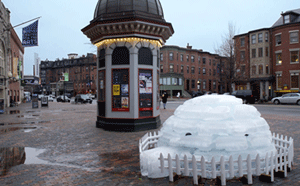
Tagiuri’s ice igloo melts away, making its own statement about global warming.(Photo: John Horner Photography)
GONZALEZ: Well, I think that it symbolizes how one person leans on another person on another person, and how if that person uses the other person . . . we can all come together and help one cause basically.
TAJ: Gonzalez is with about a dozen other teenagers from Boston's Trinity Church visiting the global warming exhibition. They were invited to eat dinner at the 13-legged table.
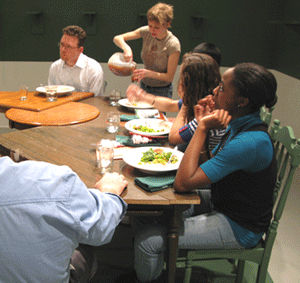
Teenagers from the Trinity Church youth group eat dinner and talk about global warming in The Mills Gallery in Boston. (Photo: Mags Harries)
HARRIES: It's really a metaphor for how problems can get solved on the very basic level. The table in a home is a place where conversation happens-sometimes difficult, sometimes great, sometimes celebratory.
TAJ : Mags Harries has hosted five meals in the gallery, inviting community groups to talk about global warming over food and drinks at her unique table. Wendy Baring-Gold, director of arts programming at the Center, says it's all about getting the public involved.
BARING-GOULD: Five of the six artists here actually have included a public participation component to the exhibition.
TAJ: So for example, John Tagiuri says visitors aren't supposed to just look at his igloo, they're supposed to get inside it and think.
TAGIURI: You can sit there and go like 'why am I here, what am I doing inside this igloo in a gallery in Boston?'
TAJ: He says art should be approachable and fun. And director Baring-Gould says because it's interactive, the show appeals to more people.
BARING-GOULD: The work is in the gallery, but the work in the gallery has been created with the participation of people who might not normally come into a gallery.
TAJ: Artist Mags Harries says she gets as much out of the exhibition as the visitors.
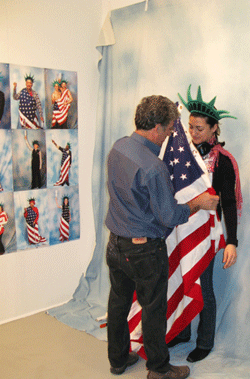
Environmental artist John Tagiuri prepares Living on Earth’s Mitra Taj to be photographed as part of his project “Compact Liberty.” Participants are dressed like the Statue of Liberty and hold a compact fluorescent lightbulb in lieu of a torch.(Courtesy of Mags Harries)
TAJ: One exhibit in particular appealed to Steven Rodenas. It was artist Clara Wainwright's “Eco-Shaman Robes,” colorful tapestries embroidered with images of endangered species.
RODENAS: We see birds in these quilts and you see birds everywhere and you say 'oh, they're going to be there by the time I'm 50. but like, when I'm 50, I'm pretty sure some of these birds aren't going to be here. And I'll be like, 'oh, I should have recycled that water bottle-if I would have made that effort I could have seen this bird, I could have seen this frog, I wouldn't have to go to the zoo.'
TAJ: As the conversation at the 13-legged table turned from what the works of art mean to how to make their church greener, the teenagers took turns trying out another of John Tagiuri's projects: “Compact Liberty.”
TAGIURI: I've been photographing people from the community, and I dress them up sort of like the Statue of Liberty. They have an American flag wrapped around them and a green crown and I get them to hold a giant compact fluorescent light bulb up like a torch.
TAJ: How do you feel?
BOK: A little goofy. But if any of this helps to bring awareness for the issues of climate change and global warming and energy use, then it's cool.
TAJ: What does the lightbulb symbolize for you?
BOK: I think it symbolizes that environmentalism is definitely patriotic. I think that how we consume our energy and where we get it-it's all about what's going on in the world today. I mean, things like the Iraq war come to mind and also how we're going to work as a country in the future.

Artist Jay Critchley projected video of himself and others yawning for the global warming art exhibit.(Photo: John Horner Photography)
HENDERSON: Well, I'm looking at two projections, and one is of random people yawning, and another is of an artist yawning, over and over again.
TAJ: The artist who devised it, Jay Critchley, says research shows that yawning helps keep our brains from overheating. He wanted to make a statement about the earth's need to cool off.
But Helen had a different interpretation.
HENDERSON: I think the artist was saying that when people hear global warming they just want to yawn and not think about it.
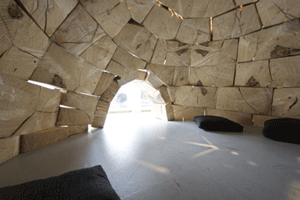
The view from inside artist John Tagiuri's "Coal Igloo." The outside is charred black, and the inside is furnished with cushions, inviting visitors to meditate on dwellings and global warming.(Photo: John Horner Photography)
BARING-GOULD: I've had a number of groups who wanted to know if they could reserve the opportunity to have a slumber party in the igloo. And we haven't quite figured out how to do that yet. You know, afternoon siestas yes, slumber parties-I'm not so sure.
TAJ: Well, here's to art taking the yawn out of global warming. For Living on Earth, I'm Mitra Taj.
Related links:
- Greed, Guilt, and Grappling
- To learn more about Mags Harries’ artwork, click here
- To learn more about John Tagiuri’s artwork, click here
[MUSIC: Trans Global Undedrground “Scorch” from Yes Boss Food Corner (Ark 21 Records 2001)]
Learn about the Fern
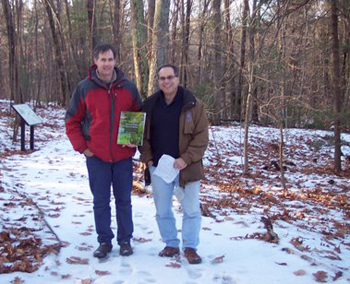
Willliam Cullina, author of the “Native Ferns Moss and Grasses,” showed reporter Bruce Gellerman native ferns in a botanical garden in Framingham, Massachusetts. (Photo: Bruce Gellerman)
GELLERMAN: Ferns usual play second fiddle in gardens, but in William Cullina's new book “Native Ferns Moss and Grasses” these emerald plants - subtle and sensuous - take their place front and center.
Cullina directs research and development at the New England Wild Flower Society, which runs the Garden in the Woods. 30 miles west of Boston in Framingham, Massachusetts, it's the premier botanical garden in the nation for plants native to America.
[SOUND OF SNOW CRUNCHING UNDER FOOTSTEPS]
A few weeks ago, Bill Cullina took me for a walk along snow-covered paths through the Garden in the Woods in search of native ferns, moss and grasses.
CULLINA: The steps might be kind of slippery, so we can go, you know, take this other path over here.
[SOUND OF WALKING, SNOW CRUNCHING]
GELLERMAN: Now why native ferns, moss and grasses? And how come it’s not mosses?
CULLINA: Well technically it should be mosses. That was something the publishers thought there were too many ss sounds in the title, so they decided to shorten it to moss. But when I first pitched this idea to my editor before I did the woody plant, she said ‘well nobody’s gonna buy a book on green, you know, it’s all green.’ And so I thought a lot, I joke about in the book, you know saying well I’m gonna go around and buy some plastic flowers and stage ‘em around in amongst all the ferns, you know, because you just naturally want to see color. But the more I thought about it and wrote about it and focused my own thinking on the matter, the grasses in the sun and ferns in the shade and mosses, too, really provide the texture and the background on which the wild flowers kind of paint so to speak. You think about a meadow without grasses --it wouldn’t look wild, it wouldn’t really look appropriate. In the same way, in most places in the woods, if you walk around in the woods, most of what you see in the understory, especially here in the Northeast, are ferns. You don’t see huge blazes of wildflowers. You see them sort of scattered around. It’s the ferns that really hold it all together.

Garden in the Woods is a wild plant sanctuary, where ferns and other plants native to America thrive.(Photo: Bruce Gellerman)
CULLINA: Yeah.
[SOUND OF WALKING, SNOW CRUNCHING]
GELLERMAN: Yeah, this is what Simon and Garfunkel would call “a hazy shade of winter.”
CULLINA: [laughs] That’s right, you know we’ve had some years where it stays mild for a long time and a lot of years when we have, you know, more than this snow by this time of year.
[WALKING, HUM OF ENGINE]
CULLINA: The property here is just under 50 acres, and you drove here so you know it’s this little sort of oasis in the middle of the suburban sprawl of Boston.
GELLERMAN: Well there’s a fern right, right there.
CULLINA: Yep, this is a Christmas fern here, so named because it is one of the few truly evergreen ferns that live around here. So most of the ferns will die back down to the ground during the wintertime, but this is really evergreen, and people used to collect these fronds for Christmas decorations, you know just a little bit of green. And people sort of joke if you look--
[WALKING OVER SNOW, STRETCHING]
CULLINA: If you look at these and you pull one of these things off they look kind of like a little stocking, one of these leaflets.
GELLERMAN: Oh yeah.
CULLINA: And so, you know that’s sort of another wives tale that’s why it’s called Christmas fern, but uh...
GELLERMAN: What’s the botanical name?
CULLINA: Polystichum acrostichoides. Most of the ferns have very interesting, sort of tongue-twisting names, and that’s one of them: Polystichum acrostichoides.
GELLERMAN: Give me some other examples of tongue-twistering names.
CULLINA: Well among the ferns -- one of my favorites is Glade fern, the Latin name for it is Diplazium pycnocarpon. And then we’ve got Hay-scented fern, which is Dennstaedtia punctilobula. So you know this -- the Latin names really, especially with ferns, they’re made to describe different features of the plants in Latin. They’re not made to be sort of easy and friendly to pronounce. That’s why common names like glade fern and hay-scented fern are kind of nice for people to have, too.
GELLERMAN: Lady fern.
CULLINA: Lady fern, yeah that’s a nice easy one.
GELLERMAN: Right, right. Now what about Lady fern -- I understand it’s like the most popular here, is that right?

Willliam Cullina wrote “Native Ferns Moss and Grasses.”(Photo: Bruce Gellerman)
GELLERMN: Is it true that Lady ferns can be found in every state but Nebraska?
CULLINA: [laughs] Yeah I bet there’s gonna be somebody out there in Nebraska proving us wrong, but according to the, you know the taxonomic work, yeah that’s basically. Why not Nebraska? Because Nebraska doesn’t have much in the way of the woodland habitat that they need. Most of the other western states have enough in the way of higher elevation habitat somewhere that Lady ferns can grow. There are some ferns like Bracken fern for instance, which is common in the woods around here, probably vying for the most common plant in the world. You can find Bracken fern on just about every continent from the, you know, the rain forests to the mountain tops and you know the boreal forests of Florida and Asia and all over the place. It’s amazing. Part of the advantage of something that’s been around for so long -- it’s been able to colonize just about everywhere, so in parts of Asia people actually collect and eat the fiddleheads of that species, but it’s a highly toxic thing and--
GELLERMAN: A toxic fern?
CULLINA: A toxic fern, yeah. Well, you gotta figure that if you’ve been around for millions of years you’ve figured out how to prevent being eaten, right? So most ferns are loaded with defensive chemicals to prevent them from being eaten. And Bracken fern has got several different kinds of poisons, so I certainly don’t recommend eating it.
GELLERMAN: Really. You know because when I think of ferns, I think of dinosaurs
CULLINA: Yeah.
GELLERMAN: And the ones that were back then, are the same as now?
CULLINA: There’s an amazing discovery, you know just in the last few years they found -- there’s a fern that grows around here called Interrupted fern: Osmunda claytoniana. And it’s a beautiful fern, it’s three foot high, it comes out of the ground it has black-- the spores that it reproduces with are, and these special fronds that are black, so it’s very sculptural when it comes out of the ground. And recently found fossils in Antarctica of all places that are two hundred million years old of this species. So it has remained unchanged for two hundred million years. You think about all the species that have gone extinct in two hundred million years, and this fern, unassuming fern is now, you know, has survived. So, it’s doing something right.
GELLERMAN: Well let’s take a little bit more walk.
[SOUND OF WALKING, SNOW CRUNCHING]
GELLERMAN: Well, I'm looking at this tree, and I was a cub scout and we learned that moss only grows on the North side of the tree. This tree has moss on only one side. Is that the North?
CULLINA: Well there’s two things we’re looking at. We’re looking at the lichens, which are going up.
GELLERMAN: That’s not moss?
CULLINA: No, lichens are different than moss. The moss is on the bottom. What you see on the sides of the tree is a lot of that are lichens. But the mosses are growing down around the base.
GELLERMAN: And the mosses are growing all around the base, so the answer is.
CULLINA: That anywhere it’s moist enough the mosses will grow, so--
GELLERMAN: I wasn’t a very good cub scout, I gotta tell you.
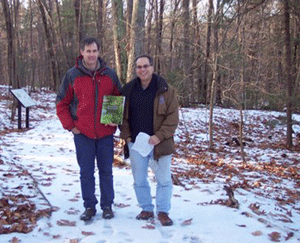
Willliam Cullina, author of the “Native Ferns Moss and Grasses,” showed reporter Bruce Gellerman native ferns in a botanical garden in Framingham, Massachusetts. (Photo: Bruce Gellerman)
[WALKING, SNOW CRUNCHING]
GELLERMAN: Bill, it would seem to me that you have the perfect job for somebody like you.
CULLINA: I do wake up everyday and think that I’m very fortunate to be doing what I love doing and also this kind of thing -- talking with other people about it -- couldn’t be happier.
GELLERMAN: Bill Cullina is director of research and development for the New England Flower Society. His new book is called “Native Ferns, Moss and Grasses.” Our story was produced with the help of Alexandra Gutierrez.
[MUSIC: The Bangles “Hazy Shade Of Winter” from The Greatest Hits (Sony BMG 1990)]
GELLERMAN: On the next Living on Earth: American astronauts will soon have to hitch rides into space aboard Russian rockets.
MAN: The fact that we are dependent on another nation's resources - that doesn't scare me - in fact I think we should celebrate that interdependence, because in fact that may be what's required to fully realize our future in space.
GELLERMAN: Missile gaps and space races -- next time on Living on Earth.
Spring has sprung! The grass is ris...I wonder where the birdies is! We leave you this week with a seasonal awakening.
[MUSIC: “Flight of the Divers” from ‘Wings Over the Prairie’ (1995 NatureSound Studio)]
In March and April waterfowl migrate north across the American prairie. At a large lake in at Arrowwood National Wildlife Refuge in North Dakota, hundreds of ducks dive to find food. They're joined by other diving water fowl, including Canvasbacks, Redheads, and Lesser Scaups, and were recorded by Lang Elliott and Ted Mack for their CD ‘Wings Over the Prairie.’
GELLERMAN: Living on Earth is produced by the World Media Foundation. Our crew includes Ashley Ahearn, Bobby Bascomb, Eileen Bolinsky, Ingrid Lobet, Helen Palmer, Mitra Taj and Jeff Young, with help from Jennifer Baessler, and Sarah Calkins. Our interns are Annie Jia and Margaret Rossano. Jeff Turton is our technical director. Alison Lirish Dean composed our themes. Steve Curwood is our executive producer. You can find us at LOE dot org. I’m Bruce Gellerman. Thanks for listening.
ANNOUNCER: Funding for Living on Earth comes from the National Science Foundation, supporting coverage of emerging science, and Stonyfield Farm, organic yogurt and smoothies.
Living on Earth wants to hear from you!
Living on Earth
62 Calef Highway, Suite 212
Lee, NH 03861
Telephone: 617-287-4121
E-mail: comments@loe.org
Newsletter [Click here]
Donate to Living on Earth!
Living on Earth is an independent media program and relies entirely on contributions from listeners and institutions supporting public service. Please donate now to preserve an independent environmental voice.
NewsletterLiving on Earth offers a weekly delivery of the show's rundown to your mailbox. Sign up for our newsletter today!
 Sailors For The Sea: Be the change you want to sea.
Sailors For The Sea: Be the change you want to sea.
 The Grantham Foundation for the Protection of the Environment: Committed to protecting and improving the health of the global environment.
The Grantham Foundation for the Protection of the Environment: Committed to protecting and improving the health of the global environment.
 Contribute to Living on Earth and receive, as our gift to you, an archival print of one of Mark Seth Lender's extraordinary wildlife photographs. Follow the link to see Mark's current collection of photographs.
Contribute to Living on Earth and receive, as our gift to you, an archival print of one of Mark Seth Lender's extraordinary wildlife photographs. Follow the link to see Mark's current collection of photographs.
 Buy a signed copy of Mark Seth Lender's book Smeagull the Seagull & support Living on Earth
Buy a signed copy of Mark Seth Lender's book Smeagull the Seagull & support Living on Earth

